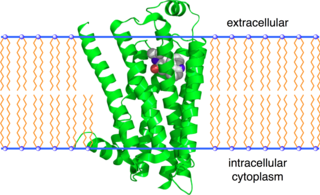Related Research Articles

The sympathetic nervous system (SNS) is one of the three divisions of the autonomic nervous system, the others being the parasympathetic nervous system and the enteric nervous system. The enteric nervous system is sometimes considered part of the autonomic nervous system, and sometimes considered an independent system.

The adrenergic receptors or adrenoceptors are a class of G protein-coupled receptors that are targets of many catecholamines like norepinephrine (noradrenaline) and epinephrine (adrenaline) produced by the body, but also many medications like beta blockers, beta-2 (β2) agonists and alpha-2 (α2) agonists, which are used to treat high blood pressure and asthma, for example.

Vasodilation, also known as vasorelaxation, is the widening of blood vessels. It results from relaxation of smooth muscle cells within the vessel walls, in particular in the large veins, large arteries, and smaller arterioles. Blood vessel walls are composed of endothelial tissue and a basal membrane lining the lumen of the vessel, concentric smooth muscle layers on top of endothelial tissue, and an adventitia over the smooth muscle layers. Relaxation of the smooth muscle layer allows the blood vessel to dilate, as it is held in a semi-constricted state by sympathetic nervous system activity. Vasodilation is the opposite of vasoconstriction, which is the narrowing of blood vessels.

Muscarinic acetylcholine receptors, or mAChRs, are acetylcholine receptors that form G protein-coupled receptor complexes in the cell membranes of certain neurons and other cells. They play several roles, including acting as the main end-receptor stimulated by acetylcholine released from postganglionic fibers. They are mainly found in the parasympathetic nervous system, but also have a role in the sympathetic nervous system in the control of sweat glands.

Oxymetazoline, sold under the brand name Afrin among others, is a topical decongestant and vasoconstrictor medication. It is available over-the-counter as a nasal spray to treat nasal congestion and nosebleeds, as eye drops to treat eye redness due to minor irritation, and as a prescription topical cream to treat persistent facial redness due to rosacea in adults. Its effects begin within minutes and last for up to six hours. Intranasal use for longer than three days may cause congestion to recur or worsen, resulting in physical dependence.

Hexamethonium is a non-depolarising ganglionic blocker, a neuronal nicotinic (nAChR) receptor antagonist that acts in autonomic ganglia by binding mostly in or on the nAChR receptor, and not the acetylcholine binding site itself. It does not have any effect on the muscarinic acetylcholine receptors (mAChR) located on target organs of the parasympathetic nervous system, nor on the nicotinic receptors at the skeletal neuromuscular junction, but acts as antagonist at the nicotinic acetylcholine receptors located in sympathetic and parasympathetic ganglia (nAChR).
alpha-1 (α1) adrenergic receptors are G protein-coupled receptors (GPCRs) associated with the Gq heterotrimeric G protein. α1-adrenergic receptors are subdivided into three highly homologous subtypes, i.e., α1A-, α1B-, and α1D-adrenergic receptor subtypes. There is no α1C receptor. At one time, there was a subtype known as α1C, but it was found to be identical to the previously discovered α1A receptor subtype. To avoid confusion, naming was continued with the letter D. Catecholamines like norepinephrine (noradrenaline) and epinephrine (adrenaline) signal through the α1-adrenergic receptors in the central and peripheral nervous systems. The crystal structure of the α1B-adrenergic receptor subtype has been determined in complex with the inverse agonist (+)-cyclazosin.
The alpha-2 (α2) adrenergic receptor is a G protein-coupled receptor (GPCR) associated with the Gi heterotrimeric G-protein. It consists of three highly homologous subtypes, including α2A-, α2B-, and α2C-adrenergic. Some species other than humans express a fourth α2D-adrenergic receptor as well. Catecholamines like norepinephrine (noradrenaline) and epinephrine (adrenaline) signal through the α2-adrenergic receptor in the central and peripheral nervous systems.

The beta-2 adrenergic receptor, also known as ADRB2, is a cell membrane-spanning beta-adrenergic receptor that binds epinephrine (adrenaline), a hormone and neurotransmitter whose signaling, via adenylate cyclase stimulation through trimeric Gs proteins, increases cAMP, and, via downstream L-type calcium channel interaction, mediates physiologic responses such as smooth muscle relaxation and bronchodilation.

Norepinephrine (NE), also called noradrenaline (NA) or noradrenalin, is an organic chemical in the catecholamine family that functions in the brain and body as a hormone, neurotransmitter and neuromodulator. The name "noradrenaline" is more commonly used in the United Kingdom, whereas "norepinephrine" is usually preferred in the United States. "Norepinephrine" is also the international nonproprietary name given to the drug. Regardless of which name is used for the substance itself, parts of the body that produce or are affected by it are referred to as noradrenergic.

A muscarinic receptor antagonist (MRA), also called an antimuscarinic, is a type of anticholinergic agent that blocks the activity of the muscarinic acetylcholine receptor. The muscarinic receptor is a protein involved in the transmission of signals through certain parts of the nervous system, and muscarinic receptor antagonists work to prevent this transmission from occurring. Notably, muscarinic antagonists reduce the activation of the parasympathetic nervous system. The normal function of the parasympathetic system is often summarised as "rest-and-digest", and includes slowing of the heart, an increased rate of digestion, narrowing of the airways, promotion of urination, and sexual arousal. Muscarinic antagonists counter this parasympathetic "rest-and-digest" response, and also work elsewhere in both the central and peripheral nervous systems.

Alpha-adrenergic agonists are a class of sympathomimetic agents that selectively stimulates alpha adrenergic receptors. The alpha-adrenergic receptor has two subclasses α1 and α2. Alpha 2 receptors are associated with sympatholytic properties. Alpha-adrenergic agonists have the opposite function of alpha blockers. Alpha adrenoreceptor ligands mimic the action of epinephrine and norepinephrine signaling in the heart, smooth muscle and central nervous system, with norepinephrine being the highest affinity. The activation of α1 stimulates the membrane bound enzyme phospholipase C, and activation of α2 inhibits the enzyme adenylate cyclase. Inactivation of adenylate cyclase in turn leads to the inactivation of the secondary messenger cyclic adenosine monophosphate and induces smooth muscle and blood vessel constriction.

The muscarinic acetylcholine receptor M2, also known as the cholinergic receptor, muscarinic 2, is a muscarinic acetylcholine receptor that in humans is encoded by the CHRM2 gene. Multiple alternatively spliced transcript variants have been described for this gene. It is Gi-coupled, reducing intracellular levels of cAMP.

The alpha-2B adrenergic receptor, is a G-protein coupled receptor. It is a subtype of the adrenergic receptor family. The human gene encoding this receptor has the symbol ADRA2B. ADRA2B orthologs have been identified in several mammals.

The beta-3 adrenergic receptor (β3-adrenoceptor), also known as ADRB3, is a beta-adrenergic receptor, and also denotes the human gene encoding it.

Alpha-blockers, also known as α-blockers or α-adrenoreceptor antagonists, are a class of pharmacological agents that act as antagonists on α-adrenergic receptors (α-adrenoceptors).

Oxaprotiline, also known as hydroxymaprotiline, is a norepinephrine reuptake inhibitor belonging to the tetracyclic antidepressant (TeCA) family and is related to maprotiline. Though investigated as an antidepressant, it was never marketed.

RDS-127 is a drug which is used in scientific research. It acts as a D2-like receptor agonist and also has some serotonin and adrenergic agonist effects, as well as some anticholinergic action, and produces both anorectic and pro-sexual effects in animal studies.

The catecholamines are a group of neurotransmitters composed of the endogenous substances dopamine, noradrenaline (norepinephrine), and adrenaline (epinephrine), as well as numerous artificially synthesized compounds such as isoprenaline - an anti-bradycardiac medication. Their investigation constitutes a major chapter in the history of physiology, biochemistry, and pharmacology. Adrenaline was the first hormone extracted from an endocrine gland and obtained in pure form, before the word hormone was coined. Adrenaline was also the first hormone whose structure and biosynthesis was discovered. Second to acetylcholine, adrenaline and noradrenaline were some of the first neurotransmitters discovered, and the first intercellular biochemical signals to be found in intracellular vesicles. The β-adrenoceptor gene was the first G protein-coupled receptor to be cloned.
Autonomic drugs are substances that can either inhibit or enhance the functions of the parasympathetic and sympathetic nervous systems. This type of drug can be used to treat a wide range of diseases an disorders, including glaucoma, asthma, and disorders of the urinary, gastrointestinal and circulatory systems.
References
- 1 2 3 4 5 6 7 8 9 10 11 12 13 14 H. P. Rang; M. Maureen Dale (2003). H. P. Rang (ed.). Pharmacology 5th ed. Churchill Livingstone. p. 127. ISBN 978-0-443-07145-4.
- 1 2 3 4 5 6 7 8 9 10 11 12 13 Costanzo, Linda S. (2007). Physiology . Hagerstwon, MD: Lippincott Williams & Wilkins. p. 37. ISBN 978-0-7817-7311-9.
- ↑ Schmitz, JM; Graham, RM; Sagalowsky, A; Pettinger, WA (1981). "Renal alpha-1 and alpha-2 adrenergic receptors: Biochemical and pharmacological correlations". The Journal of Pharmacology and Experimental Therapeutics. 219 (2): 400–6. PMID 6270306.
- ↑ Woodman, OL; Vatner, SF (1987). "Coronary vasoconstriction mediated by alpha 1- and alpha 2-adrenoceptors in conscious dogs". The American Journal of Physiology. 253 (2 Pt 2): H388–93. doi:10.1152/ajpheart.1987.253.2.H388. PMID 2887122.
- ↑ Rang, H. P. (2003). Pharmacology. Edinburgh: Churchill Livingstone. p. 270. ISBN 978-0-443-07145-4.
- ↑ Circulation & Lung Physiology I M.A.S.T.E.R. Learning Program, UC Davis School of Medicine
- ↑ Morton, J S; Daly, C J; Jackson, V M; McGrath, J C (2009). "Α1A-Adrenoceptors mediate contractions to phenylephrine in rabbit penile arteries". British Journal of Pharmacology. 150 (1): 112–20. doi:10.1038/sj.bjp.0706956. PMC 2013850 . PMID 17115072.
- ↑ Elliott, J. (1997). "Alpha-adrenoceptors in equine digital veins: Evidence for the presence of both alpha1 and alpha2-receptors mediating vasoconstriction". Journal of Veterinary Pharmacology and Therapeutics. 20 (4): 308–17. doi:10.1046/j.1365-2885.1997.00078.x. PMID 9280371.
- ↑ Mauduit, P; Herman, G; Rossignol, B (1984). "Protein secretion induced by isoproterenol or pentoxifylline in lacrimal gland: Ca2+ effects". The American Journal of Physiology. 246 (1 Pt 1): C37–44. doi:10.1152/ajpcell.1984.246.1.C37. PMID 6320658.
- ↑ Sagrada, A; Fargeas, M J; Bueno, L (1987). "Involvement of alpha-1 and alpha-2 adrenoceptors in the postlaparotomy intestinal motor disturbances in the rat". Gut. 28 (8): 955–9. doi:10.1136/gut.28.8.955. PMC 1433140 . PMID 2889649.
- 1 2 Poretsky, Leonid (2010). "Parasympathetic Nerves". Principles of diabetes mellitu. New York: Springer. p. 47. ISBN 978-0-387-09840-1.
- 1 2 Duttaroy, A.; Zimliki, C. L.; Gautam, D.; Cui, Y.; Mears, D.; Wess, J. (2004). "Muscarinic Stimulation of Pancreatic Insulin and Glucagon Release is Abolished in M3 Muscarinic Acetylcholine Receptor-Deficient Mice". Diabetes. 53 (7): 1714–20. doi: 10.2337/diabetes.53.7.1714 . PMID 15220195.
- ↑ Kullmann, F. A.; Limberg, B. J.; Artim, D. E.; Shah, M.; Downs, T. R.; Contract, D.; Wos, J.; Rosenbaum, J. S.; De Groat, W. C. (2009). "Effects of 3-Adrenergic Receptor Activation on Rat Urinary Bladder Hyperactivity Induced by Ovariectomy". Journal of Pharmacology and Experimental Therapeutics. 330 (3): 704–17. doi:10.1124/jpet.109.155010. PMC 2729793 . PMID 19515967.